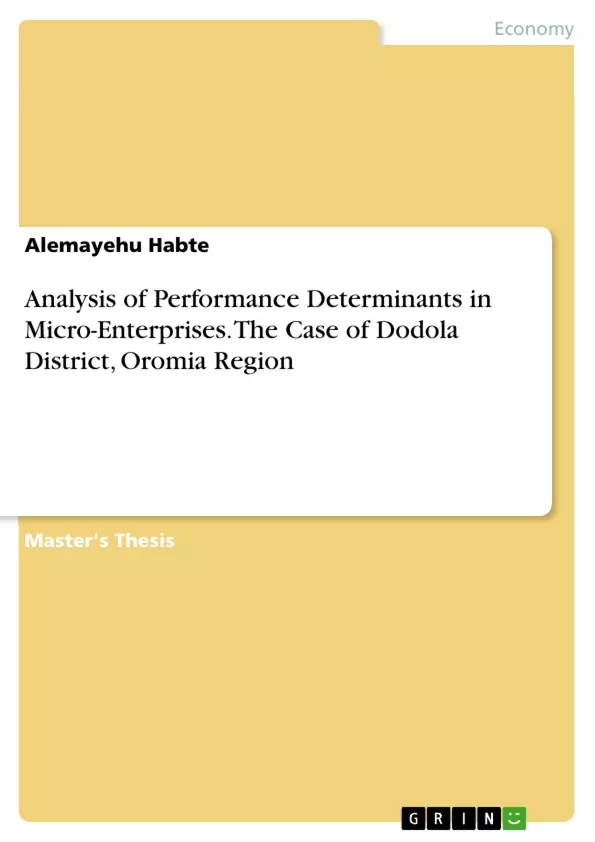Nowadays, the contribution of micro-enterprises in employment creation, poverty reduction and hence economic growth is getting widespread acknowledgement.
However, their performance is usually constrained by various factors.
Thus, this research is basically aimed at investigating key determinants of performance among micro-enterprise businesses in Dodola town of Oromia region.
It examines the extent to which performance of micro-enterprises is associated with characteristics of the owner and business constraints.
To this end, primary data were gathered using interview schedule from a sample of 112 micro-enterprises selected using stratified random sampling.
Besides, two Focus Group Discussions were held with fourteen randomly selected micro-entrepreneurs.
To further triangulate the data Key informant interviews were held with three MSE office heads.
Then after primary data was analyzed using both descriptive and inferential statistics.
Characteristics of the enterprises and their entrepreneurs were analyzed using percentage, mean, median and standard deviation.
On the other hand, Pearson’s chi-square(x2), paired sample t-test and multinomial logistic regression were used to make inferences about the subject under investigation.
In this study, performance of micro-enterprises was measured in terms of two main indicators namely profit and employment growth.
The results of paired t-test indicated statistically significant mean difference in socio-economic status of entrepreneurs before and after starting micro-enterprise business.
The multinomial logistic regression analysis revealed that education, experience, location and access to formal credit source are significant predictors of profit growth.
However, only education was found as a significant predictor of employment growth.
Key Words: Micro-enterprise; Performance; Multinomial Logistic Regression; Performance Determinants.
Inhaltsverzeichnis (Table of Contents)
- CHAPTER ONE.
- INTRODUCTION.
- 1.1. Background of the Study.
- 1.2. Statement of the Problem
- 1.3. General Objective of the Study
- 1.4. Specific Objectives of the Study
- 1.5. Hypothesis......
- 1.6. Significance of the Study..
- 1.7. Delimitation of the Study
- 1.8. Limitation of the Study.
- 1.9. Organization of the Study.
- CHAPTER TWO.
- REVIEW OF LITERATURE
- 2.1. Theoretical Literature
- 2.2. Conceptual Framework..
- 2.3. Definition and Concept of Micro and Small Enterprises..
- 2.4. Empirical Literature...
- 2.4.1. Personal attributes.
- 2.4.2. Demographic characteristics.
- 2.4.3. Socio-cultural variables...
- 2.4.4. Business Characteristics of the Enterprise.
- 2.4.5. Infrastructure....
- 2.4.6. Business Development Services..
- 2.4.7. Legal and regulatory environment.
- 2.4.8. Access to finance....
- 2.4.9. Lack of Linkage or Business Cooperation amongst Enterprises....
- 2.4.10. Access to market.
- 2.5. Micro-enterprises in Ethiopia
- CHAPTER THREE
- METHODOLOGY
- 3.1. Description of the study area.
- 3.2. Research Design
- 3.3. Sample Size Determination
- 3.4. Sampling Methods...
- 3.5. Methods of Data collection...
- 3.6. Data analysis techniques..
- 3.6.1. Model specification.
- 3.7. Description of Variables.
- 3.7.1. Independent variables.
- 3.7.2. Dependent variables.
- CHAPTER FOUR..
- RESULTS AND DISCUSSION.
- 4.1. Demographic Information of respondents..
- 4.2. Basic Characteristics of the Micro-enterprises...
- 4.3. Source of initial capital
- 4.4. Characteristics of micro-enterprises in Dodola town.
- 4.5. Reason for starting business..
- 4.6. Financial Management..
- 4.7. Use of Business Development Services.
- 4.8. Performance of micro-enterprises ..
- 4.9. Socio-economic characteristics of micro-entrepreneurs.
- 4.12. Multinomial logistic regression results of annual profit and selected explanatory variables....
- 4.13. Regression results of employment growth and selected explanatory variables.
- 4.2. Discussion..
- CHAPTER FIVE
- SUMMARY, CONCLUSION AND RECOMMENDATION
- 5.1. Summary and conclusion
- 5.2 Recommendation....
Zielsetzung und Themenschwerpunkte (Objectives and Key Themes)
This thesis aims to analyze the determinants of performance in micro-enterprises in the Dodola District of the Oromia Region of Ethiopia. The study seeks to identify key factors that influence the financial performance and employment growth of these micro-enterprises, providing insights into the challenges and opportunities facing this sector.
- Impact of personal attributes, demographic characteristics, and socio-cultural variables on micro-enterprise performance.
- Influence of business characteristics, infrastructure, and access to finance on micro-enterprise growth and profitability.
- Role of business development services, legal and regulatory environment, and market access in shaping micro-enterprise performance.
- Analysis of the unique context of micro-enterprises in Ethiopia and their specific challenges and opportunities.
- Evaluation of the effectiveness of various interventions and policies designed to support micro-enterprise development in Ethiopia.
Zusammenfassung der Kapitel (Chapter Summaries)
Chapter One introduces the background of the study, outlining the importance of micro-enterprises in Ethiopia's economic development and highlighting the need for a deeper understanding of their performance determinants. The chapter defines the research problem, states the objectives, and presents the hypothesis guiding the research. It also discusses the significance and limitations of the study.
Chapter Two delves into the theoretical and empirical literature related to micro-enterprise performance. It explores various frameworks, including the role of personal attributes, demographic characteristics, business characteristics, infrastructure, and access to finance in shaping micro-enterprise success. The chapter also examines the specific context of micro-enterprises in Ethiopia.
Chapter Three outlines the methodology employed in the study, including the research design, sample size determination, sampling methods, data collection techniques, and data analysis techniques. It describes the variables under investigation and the statistical models used to analyze the data.
Chapter Four presents the findings of the study, examining the demographic characteristics of the respondents, the key features of the micro-enterprises, their sources of capital, and the reasons for starting their businesses. The chapter also analyzes the financial management practices of micro-entrepreneurs and their use of business development services. Finally, it investigates the performance of micro-enterprises, including their profitability and employment growth.
Schlüsselwörter (Keywords)
The key terms and concepts explored in this research include: micro-enterprises, performance determinants, financial performance, employment growth, personal attributes, demographic characteristics, business characteristics, infrastructure, access to finance, business development services, legal and regulatory environment, market access, Ethiopia, and micro-enterprise development.
- Arbeit zitieren
- Alemayehu Habte (Autor:in), 2012, Analysis of Performance Determinants in Micro-Enterprises. The Case of Dodola District, Oromia Region, München, GRIN Verlag, https://www.grin.com/document/306207



